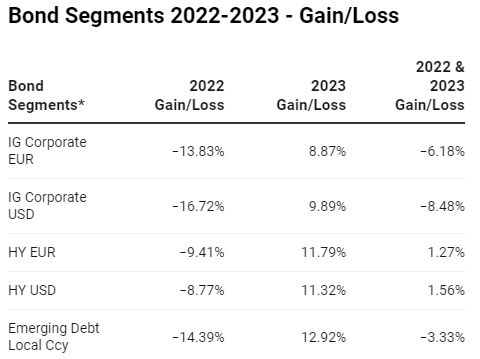U.S. Treasuries ended the year roughly at the same place they began, concealing some wild moves for the 10-year benchmark in 2023. Its yield remained virtually unchanged year-over-year, at 3.88%. Yet it surged to 5% in mid-October after falling to 3.25% in early April. The 2-year Treasury yield lost 16 basis points over the year from 4.41% to 4.25%. The inversion of the yield curve has therefore been somewhat reduced. Investors approach the year 2024 with optimism after the Federal Reserve has flagged an end to more interest rate hikes and said rate cuts are likely in 2024.
The movement on long-term interest rates was more pronounced in Europe with the 10-year Bund yield down 55 basis points from 2.57% to 2.02% despite hawkish European Central Bank (ECB) commentaries. However, the Eurozone year-on-year fell to 2.4% in the most recent reading in November and the European economy is flirting with recession. It's hard to believe the ECB will not cut rates if inflation continues to decline in 2024 and the economy slows down significantly.
The prospect of lower rates, a resilient American economy and a weakening greenback favored the riskiest bond segments in 2023, emerging debt included. Even though not all have recovered from the losses suffered in 2022 - only high-yield bonds have managed to do so -, the gains recorded in 2023 were significant.

The year 2024 looks promising for bonds with high real interest rates. Furthermore, macroeconomic prospects - slowdown in growth with less fiscal support - suggest a restoration of the inverse relationship between stocks and bonds (negative correlation) that could improve portfolio diversification.
